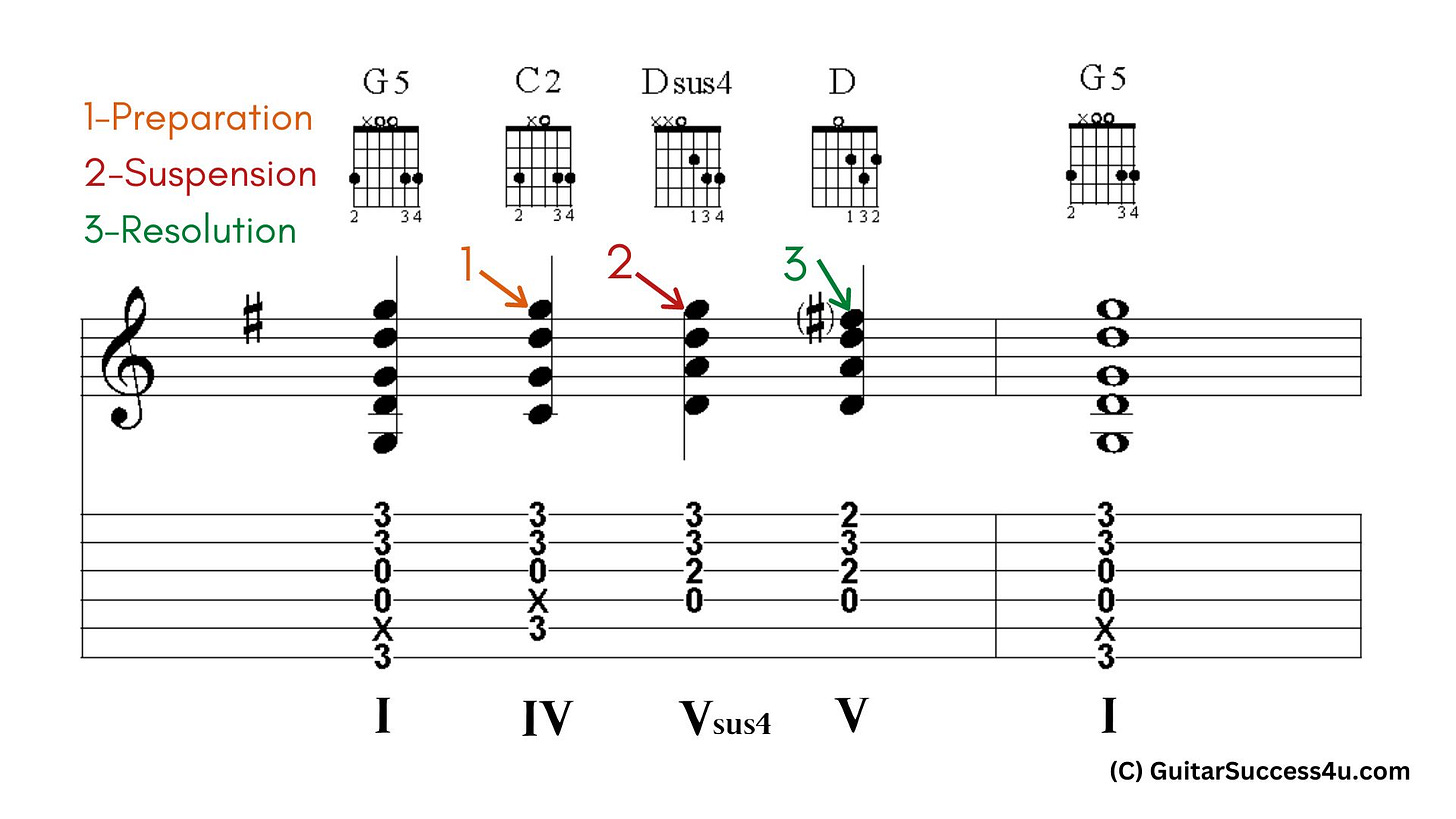Enjoy the chart below, with transcript…
Have you ever seen the abbreviation “Sus” in a chart and thought, “What does that actually mean?” Today we’re going to talk about…suspensions with music on the guitar.
I encourage you to catch the video version of this article while it’s available. This way, you’ll see and hear everything demonstrated. You can find the video right here:
If you’ve ever seen a suspenseful movie, or if you’ve ever had the unfortunate experience of having an account suspended, or your driver’s license suspended, you have experienced suspense.
But what do all of these scenarios have in common? They are all temporary. A suspenseful movie can’t be suspenseful the entire time – it just wouldn’t work. A suspended account is usually restored to good standing when the balance is paid, and a suspended driver’s license can eventually be reinstated.
So, I’m not talking about something being permanently taken away – I’m talking about something being temporarily suspended, and eventually – wait for it – resolved.
So, let’s take a moment to discuss what suspensions can look and sound like on the guitar, and why they’re important.
So, when we see the term “sus” in a chart, that’s short for a SUSpended chord.
First of all, the most common chord we’ll find suspensions for is going to be on the Dominant, the V chord in a Major key. And second of all, the most common type of suspension or “sus” chord we’re going to experience is the “sus4.” We could go in all sorts of additional directions, but for now, let’s keep things pretty simple.
So, let’s say we’re in the key of G Major, a very guitar-friendly key. The Dominant or V chord in G is D. But today, we’re not just going to play it as a D Major chord, we’re going to play it as a Dsus4 chord.
Now, my background in music began with a classical degree, which included several years of collegiate music theory, so I’m going to offer you an additional level of musicality here. It involves a three-word process. That process is: “Preparation,” “Suspension,” and “Resolution.”
Because, if we think about it, it’s nice to be able to prepare ourselves for suspense, so we can anticipate it just a bit. The plot thickens in a movie. We get a warning notice that our account is about to be suspended. The cop car behind us fires up the lights on his roof to let us know we’re about to be pulled over, which could lead to a suspended license.
So “Preparation” is the first step. The second step is the actual “Suspension.”
This is where things are in a temporary state of suspense that is typically not restful. The suspenseful scene happens in the movie, putting us on the edge of our seats. Our account is suspended, so we can’t have access to it. Our license is suspended so it’s temporarily taken away.
So, with this suspension, there’s a bit of tension. There’s tension, but in this musical scenario, this is a good sort of tension. But as I mentioned, we aren’t going to stay in suspense indefinitely. Eventually, we get to the third step, “Resolution,” where the Suspension ends.
The suspense in the movie plot winds down, if only temporarily, as it comes to a resting point in the story. The account is restored. The license is reinstated.
So, again, think through those three words as we continue - “Preparation,” “Suspension,” and “Resolution.”
So here we are in the key of G Major. The I chord in G Major is…G Major, right? The IV chord is C Major, and the V chord is D Major.
Now, to bring this right to your fingers in an easy manner, I’ll actually use some “color” chords, so the chords will actually be easier to play, and they also won’t be pure Major chords, but they’ll still totally work for this exercise.
The most important note in this suspension exercise is the high G note on the 3rd fret of the 1st string. I want you to watch this note carefully, because it’s going to remain for three chords, but it will have a different identity in each.
I’ll analyze the first chord as a G5 chord with no 3rd. So, in the G chord, this high G is the root, right? But then, when we move to a C2 chord for the IV chord, we still keep that G up on the 3rd fret of the 1st string, and now it’s the 5th of that chord. It’s at this stage that we start to feel the “Preparation.” In other words, we’re ramping up to the Suspension.
Next up is the V chord, D, but we’re going to keep the high G note on that 3rd string, thereby rendering this chord a Dsus4. Why is it a Dsus4? Because the high G is now the 4th degree of the D chord.
Now, typically a D Major Chord won’t have a G in it, but rather an F#, right? But here, with this chord, the Vsus4 is providing the Suspension we’re after. Right now, it’s not a Major chord.
So now we’ve been put in suspense. It’s not a restful chord. It’s a chord where we’re temporarily “on edge” just a bit.
But what follows a Suspension, ideally? You know it – Resolution.
All we need to do is take that high G note that we’ve had with us all along, and let it resolve down to the F#, thereby establishing the D Major chord, on its way back to…the G chord. See how the Vsus4 chord moves to a Major V chord, and finally back to the I chord?
It’s actually quite pleasing to the ear. (Catch the video for the demonstration of this.)
Is there more? Always. Can we create a Sus2 chord? Yep.
Can we create suspensions with 7 chords? Yeah buddy.
Can we play suspensions as bar chords? Of course.
Can we play a suspension without preparing or resolving it? We’re technically not playing them functionally as suspensions, but…sure.
Can suspensions resolve to minor chords? Yes, but that tends to sound a little more “Foreign” in some cases (catch the video for my music reference.)
As you can see, we can go much further. But it all starts here with this simple process of KNOWING what a suspension is, and then experimenting with the intentional approach of Preparing, Suspending and Resolving.
Want to go deeper and transform your guitar journey? Check out what we offer at www.GuitarSuccess4U.com.
Keep showing up, and I’ll see you next time.












